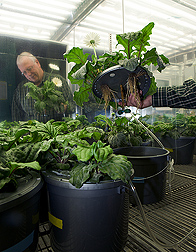This page has been archived and is being provided for reference purposes only. The page is no longer being updated, and therefore, links on the page may be invalid.
|
Read the magazine story to find out more. |
|
|
|
|
Tip for Greenhouse Growers: Add Silicon
By Don ComisMay 2, 2007
Modern greenhouse production methods have often eliminated conventional earth as a growth medium and, with that, eliminated silicon, a mineral naturally found in soil.
Greenhouse growers might do well to add silicon back in their nutrient applications, irrigation or potting mixes, according to Agricultural Research Service (ARS) scientists. That's because a growing body of research suggests that silicon boosts yields and protects plants from toxicity and fungal diseases. This means silicon may reduce the need for plant growth regulators and disease-control pesticides.
Over the past three years, horticulturist Jonathan Frantz and plant pathologist Jim Locke with the ARS Greenhouse Production Research Group in Toledo, Ohio—along with other ARS and University of Toledo colleagues—have studied silicon uptake in a variety of ornamentals, including begonia, carnation, geranium, impatiens, marigold, orchid, pansy, petunia, snapdragon, verbena and zinnia.
X-ray analysis has shown that some of these plants—such as New Guinea impatiens, marigold and zinnia—accumulate silicon in significant concentrations in unique cells in their leaves. The researchers want to see which crops put nutrients where they are most useful to the plant.
The scientists also tested some of these plants to see if silicon imparts resistance to two widespread pathogenic fungi, gray mold and powdery mildew. They found that it helps reduce symptoms of powdery mildew in zinnia but has no effect on species such as begonia and geranium, which do not accumulate silicon.
The scientists will continue to use similar tests to see if silicon accumulates in the leaves of other ornamental crops and test those crops for silicon-induced resistance to insect pests.
Such knowledge about plants' silicon use will help breeders choose promising lines for creating new varieties of flowers and ornamental plants that will need fewer pesticide applications.
Read more about the research in the May/June 2007 issue of Agricultural Research magazine.
ARS is the U.S. Department of Agriculture's chief scientific research agency.

